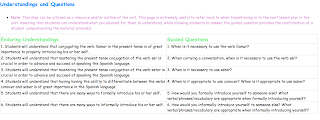As I was writing my understandings and questions for this unit, I looked it over and could not help but think that it appeared as extremely redundant and repetitive. It is very often that understandings and questions for any topic can appear as being extremely repetitive because they state "Students will understand that...." multiple times. For this unit specifically, I found that every understanding needed to basically sound the exact same, minus the verb being presented to the students.
In my many years of Spanish classes, and throughout the five teachers that I have been educated by, each and every one of them have either re-taught or reviewed the five verbs presented in this unit I am completing. The teaching and reviewing of these verbs is a result of their importance and often use in the Spanish-speaking community.
Each verb that I am going to introduce to students in this lesson plan has its own specific importance. The verb llamar allows one to tell another, or ask another person what their name is. Llamar literally translates in English as "to call oneself," as opposed to how many first think of this as "my name is." Therefore, when you ask someone "Como te llamas?" You are asking, "What do you call yourself?" I decided that this verb would be the first verb to learn for my future students because I want them to not only be able to begin an introduction with their name, but also to be able to begin the process of conjugating present tense verbs.
The second verb that they will be learning is "Ser" which translates in English as "to be." This verb is used to educate someone on your personal appearance, personality traits/characteristics, and basically anything about one self that is permanent, or something long-term. For example, "Yo soy un estudiante," translates to "I am a student." This verb, coupled with estar, could be argued as the most important and useful verbs to have understanding of in the Spanish language.
Following the verb ser, is the verb, "estar." Like ser, "estar" translates in English as "to be." Different from ser, estar is used to educate someone on something about yourself, someone else, etc., on something that is not permanent. Estar would be used to inform someone on the way in which you are feeling in that given moment. For example, "Yo estoy triste," translates to "I am sad." Being sad is most often not something that is permanent, therefore you use estar instead of ser.
Through these first three verbs that students will be presented with, they will be educated on how to conjugate verbs that end with -AR and verbs that end with -ER. The next two lesson plans will hopefully become even easier for students to comprehend because they will have already been introduced to the conjugations of -AR and -ER verbs. The last two lessons in the unit will be used to focus on sentence structure, and specifically structuring questions. The verbs that were introduced to them in the first four lesson plans will be the verbs required to use in the questions and sentences structured by the students.
The reasoning behind using an enduring understanding and question for each lesson plan is mainly so you as an educator can assure that students are learning the correct material, avoiding any confusion. At the end of each lesson, students should be able to provide an explanation in response to the guided question. This does not necessarily mean that they need to be asked the question directly, but through formative and summative assessments, they will exemplify understanding of the content discussed.
Explore My Wiki
Explore My Wiki

No comments:
Post a Comment